Drone guide and tutorial: How to take spectacular drone shots while windsurfing
Julienne Lippertz
· 08.08.2025
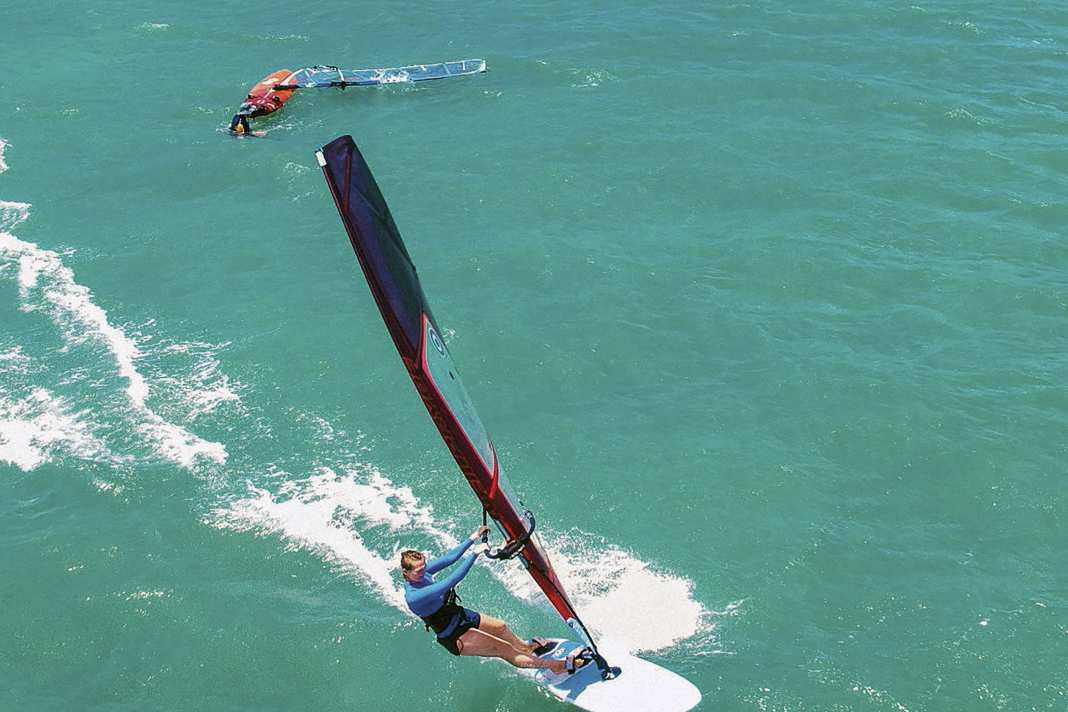





- Free flight to prison
- What you should bear in mind when flying, filming and photographing with a drone
- The drone basics: learning to fly and composing images
- FPV drones have advantages and disadvantages
- Problematic for drone sessions: Wind, crowded spots and kiters
- Drone driving licence and regulations
- These are no-gos when flying drones
For a few years now, drones have been used in competitions as an alternative to expensive helicopters for live broadcasts and also for professional shots of windsurfers. But as a hobby surfer, you also want a nice photo on the water. Drones open up completely new perspectives and are an attractive alternative to conventional camera equipment. The person taking the photo or filming from a distant beach can still take high-quality, spectacular shots from angles that are almost impossible to reach with conventional cameras. They deliver impressive images and videos, especially in action sports such as windsurfing, where dynamics and surroundings play an important role. While photographers with waterproof equipment often have to be close to the action, a drone can usually fly along from a safe distance and still deliver impressive shots. However, there are a few things to consider in order to produce truly satisfactory results.
Together with drone experts Johannes Hertel and Paul van Bellen, we have compiled a lot of information about drones, the perfect shots and laws for you. Johannes lives in Portugal and films and photographs professionally at the big wave spot Nazaré and at the Windsurf World Cups. Paul comes from Western Australia and has achieved worldwide fame with his drone videos on YouTube.
Free flight to prison
But first, a short, personal episode that shows that drone amateurs should not approach the subject of drones too lightly. What began as an ordinary surfing trip to Egypt with camera equipment ended in a scenario that looked like something out of a film: military uniforms, interrogations, suspicion of espionage and in the middle of it all me, a young student with a brand new drone in my luggage. I had been wondering for months whether it was worth buying. As a windsurfer and content creator, the DJI Mini 3 was my gateway to impressive aerial shots. But as soon as I landed at the airport in El Naaba, reality hit me with full force: Three men - two armed, one in a wetsuit - asked me to step aside. What followed was probably the longest hour of my life. The man in the wetsuit asked me to follow them - I still had no idea what was going on. My visa was stamped, my luggage was complete, I had nothing to hide. Nevertheless, I got a queasy feeling that increased with every step I took through the security areas. However, I realised that no matter how nervous and unsure I was, I had to remain calm and friendly on the outside. Away from the crowds in the airport, they finally asked me to open my rucksack and case. I did, still unsure of what it was all about - until they saw the drone. Their reaction was immediately noticeable: the looks became more serious, the body language more tense. The man in the wetsuit explained to me that drones are banned in Egypt - for security reasons, because of the possibility of them being used for espionage purposes.
Three men - two armed, one in a wetsuit - asked me to step aside. What followed was probably the longest hour of my life."
I was completely surprised. I had familiarised myself with flight regulations, but not in detail with the specific import regulations of each country. I calmly explained that I was only here as a windsurfer and that I wanted to film for social media and private holiday shots. But it wasn't that simple. The drone was confiscated and I was taken to an office. There I sat, not knowing exactly what was going to happen. The officer told me several times that I was lucky - at another airport I would have been arrested immediately without questioning. Only recently, he told me, someone had been arrested on suspicion of espionage. The conversation was halting - his English was bumpy, my Arabic non-existent. I continued to try to stay relaxed, even though I was becoming increasingly anxious inside. Especially when he started to fill out forms in Arabic and asked me to sign them - without me understanding the content. After a long wait and several phone calls to the National Security Agency, the decision was finally made: I was allowed to continue travelling, but the drone had to stay at the airport. I was given a note with which I could supposedly pick it up again on my departure. Would that really work? I had no idea. Nothing felt safe at that moment. But at least I was allowed to carry on and hope that the return flight wouldn't turn out to be a second war of nerves.
What you should bear in mind when flying, filming and photographing with a drone
Getting a drone into the air is now easier than ever thanks to modern technology - but producing truly impressive shots requires more than just pressing the start button. Whether you're a beginner or an experienced pilot, to realise the full potential of your drone camera, it's important to use the right settings, flight routes and techniques for a stable flight with creative perspectives. So how do you get started? Johannes and Paul agree: go to a large open area, such as a field, and practise the basics.
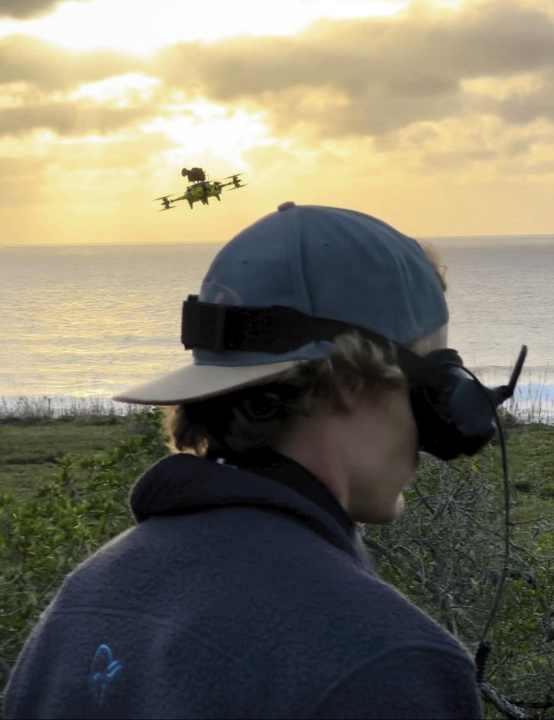
In the interview, Johannes likes to use the comparison with driving a car: "When I had my driving lessons, I remember that you had gearstick, clutch, brake, accelerator, steering wheel and you understood everything in theory - press the clutch, put it in gear, let the clutch come in, accelerate and drive. But the combination was a challenge in practice. Now you just drive and you don't even think about every step. You've automatically memorised what the individual steps are. And it's exactly the same with drone flying, so you can think, what makes more sense in driving school? Chasing learner drivers with zero experience straight onto a racetrack and telling them to hold on tight and go for it? Or first of all relax and work on the basics without any additional stress?"
The drone basics: learning to fly and composing images
Hence the first tip from both of them for a beginner in flying: learn the basics first, then concentrate on the rest. "I think the other thing I consider important when flying drones is a basic understanding of how to compose an image properly," says Paul. It's not just flying skills that are important, but also a few photography basics. In addition to the flying exercises on a large open area, Johannes recommends looking for or positioning an object in the centre of this area. This allows you to practise on a stationary object first, framing it correctly during the flight and also practising different angles and positioning. You can also find many tutorials and videos online about flying and photographing with a drone. Johannes Hertel now even offers an "Online Drone School" himself.
Once you have the basics down, you can get down to the details. "Wind knowledge is extremely helpful," explains Johannes. If you think from the perspective of a windsurfer and also think about the wind direction and strength during the flight, you can make the flight a lot easier. Nevertheless, you reach your limits with standard drones in tougher conditions and should not underestimate them. "It feels like you're trying to overtake uphill with a lorry and trailer," says Johannes about his experience with the Mavic drone at the super windy World Cup spot of Pozo. You need a lot of experience, skills and self-confidence before you can take on such tough conditions.
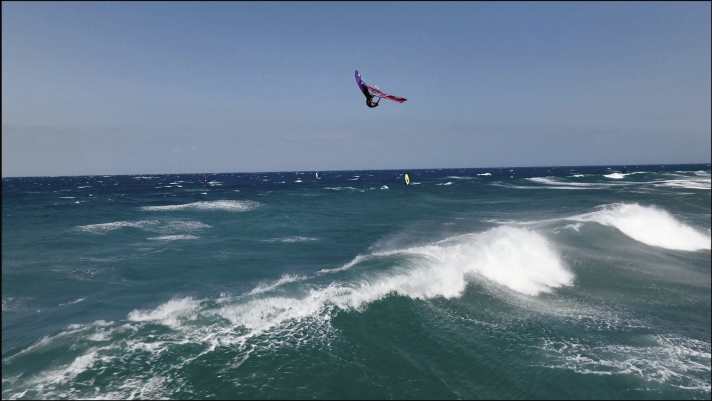
How does Paul approach a shot - does he position his drone and then wait for the windsurfer or does he follow the surfer? "With windsurfing, it's often difficult to get close because everything is so dynamic - the waves are moving, the person is moving. This makes it difficult to simply stand somewhere and catch the perfect moment. Modern drones with a zoom function help a lot. You can stay further away, frame it well and hope that the windsurfer goes where you expect him to. I'm increasingly trying to use the drone more like a stationary camera - that is, to position it as if it were standing on a tripod and then simply follow the action. A static image section often looks more natural because we humans usually observe our surroundings from a fixed perspective. Of course, you sometimes have to move when taking windsurfing shots - especially if you want to follow a slalom rider. But overall, I often just try to find a good angle, 'park' the drone there and take the picture still."
Consider the limits and battery life of the drone
However, if you want to film or generally take photos from a position where you are following the surfer, it is difficult to keep the windsurfer in focus at all times. Especially in the waves, says Paul, a zoom is rather impractical, for example, as you can quickly lose the surfer from the camera's field of vision. Paul requires a good basic knowledge of drone flying. You need to have enough control and a sense of security to be able to fly close enough to the surfer, especially with a drone without a zoom. However, when it comes to tracking a windsurfer, speed plays a major role. If you want to film a slalom rider, for example, they can easily be too fast for the drone. The size and wind resistance of the drone naturally play a major role here - it is important to be aware of the limits of your drone in advance. Especially when flying in stronger wind conditions, it is important to bear in mind that the drone may not be able to reach its maximum speed.
You should also keep an eye on the battery life. Paul points out that, depending on the wind, the drone uses less battery when flying out than it might need for the return flight if there is a headwind, so you can't always rely on the drone's calculations as to when it has to come back at the latest. In general, the limits of the drone depend on the environment. When filming in waves, for example, Paul says he has no problems with his Mavic - the surfer usually has a speed of 25 knots and the Mavic can manage up to 40 knots. With a slalom rider, who can easily do 35 knots or more, it becomes more difficult to keep up. So if you haven't positioned the shot or don't start directly with the surfer, you usually won't be able to catch up. You simply reach the limit of conventional drones.
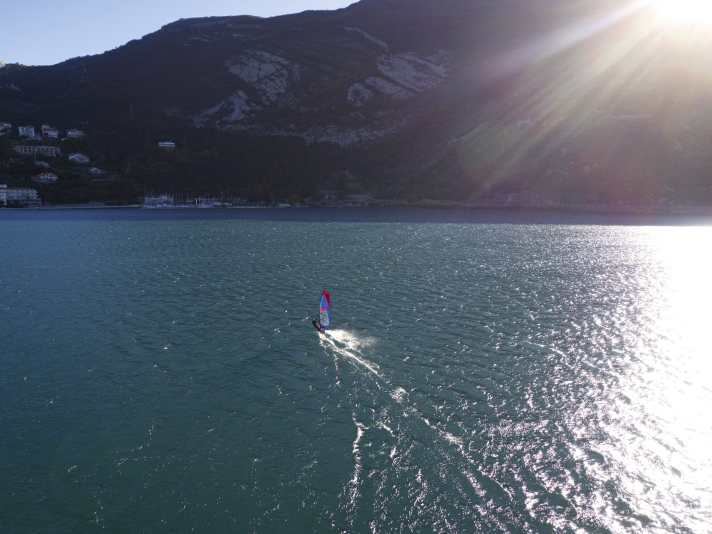
FPV drones have advantages and disadvantages
If you know anything about drones, the term FPV (First Person View - the drone pilot sees what is being filmed directly through goggles) will probably spring to mind. This type of drone is particularly manoeuvrable and fast, so it is often used for racing and dynamic filming. However, it is also far more complicated or strenuous to fly. Opinions on FPVs are very divided and the two experts also have different views. Johannes is a big fan of FPVs. Both have advantages and disadvantages and Johannes clearly states that it simply depends on what you want to do: "The FPV drone is simply practical in places where a conventional drone reaches its limits in terms of speed. However, if you want to film a race in reverse flight, for example, this is not really possible with the tilt angle of the FPV. Where an FPV drone expands the possibilities, the GPS drone simply offers more convenience."
Where an FPV drone expands the possibilities, the GPS drone simply offers more convenience." (Johannes Hertel)
The thing that Paul dislikes most about FPV is that it is much more strenuous to fly. Johannes also agrees: "25 to 30 minutes felt like five hours of live streaming." In general, however, they both say that it really depends on what you expect from your recordings afterwards: With FPV, you achieve faster, dynamic shots - the GPS drone offers calmer, cinematic shots.
Problematic for drone sessions: Wind, crowded spots and kiters
Correct communication with the windsurfer is also very important. The pilot and windsurfer should discuss in advance which manoeuvres are planned and in which area the surfer should move. Long strokes without any action will only use up battery life unnecessarily. Even if you have several batteries, they have to be changed in between and it's a shame if the windsurfer does something spectacular at the exact moment when the battery is being changed. However, the pilot should always bear in mind that not all surfers can judge what a drone will do next. For example, Paul lost one of his drones: he was filming a windsurfer from close up in super light winds. What he couldn't see from land: Another surfer was coming from behind - all at walking speed, so to speak. When he flew backwards a little for his shot, the drone crashed into the mast. So it's important: Always assume that others are not thinking along with you.
The biggest danger? Kiters - they have my full respect, but from a drone perspective they are terrible." (Paul van Bellen)
When asked what the most difficult conditions for flying are, Paul gives a rather unexpected answer: "Kiters - they have my full respect, but from a drone perspective they are terrible." With a drone, you should always be on the lookout for obstacles and not rely on the drones' obstacle detection. Kites in particular can quickly get in the way and be difficult to see. Paul also sees wind conditions over 35 knots and generally full spots as a major challenge. In his native Western Australia, he also struggles a lot with the sun. When he wants to film at his home spot in the afternoon, it can be hard to see the water with the naked eye and recognise anything because the sun is so blinding.
Light and settings: Be creative!
However, the sun can also be used to your advantage. When it comes to the general composition of an image, the experts recommend simply trying it out. "Let's say you're filming your boyfriend or girlfriend. Film him or her once with the sun behind them. Then also with the sun on the other side. And then go to different positions - take five or six shots from different angles and look at them later on the computer at home to see which ones look best," recommends Paul. Over time, you'll develop a feeling for which settings and lighting conditions work best for you. It can also happen super quickly that a shot looks like nothing on the display when you take it, but you realise later on the screen at home that it turned out to be a super cool shot.
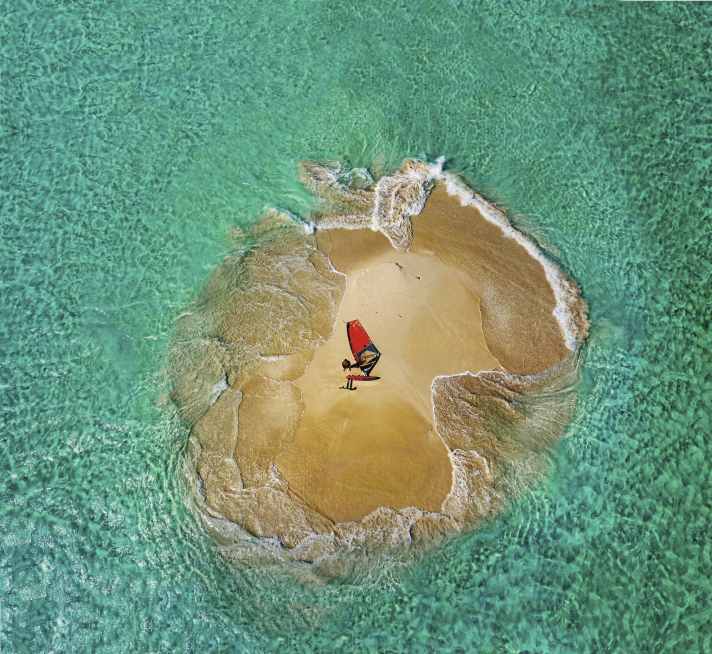
What Paul, for example, sees as one of the major disadvantages, he also likes to use to his advantage. The strong glare of the sun at his home spot makes for great shots of the spray in the wave. So it's always important to simply experiment and let your creativity run free. Paul would like to say to experienced pilots: "Be creative! You don't always want to see the same thing, not even of yourself, so it's important, even as an experienced photographer with a drone, to keep trying new things. New perspectives, new angles, new lighting conditions. Don't stop being creative and always get the most out of your shots."
If you think of it without the camera, a drone is actually a small flying lawnmower!" (Johannes Hertel)
Drone driving licence and regulations
Now you've decided on a suitable drone (buying advice in surf 9/2025), practised flying and taking photos and feel ready for some cool windsurfing shots. What else should you bear in mind when handling and travelling with a drone to avoid being taken away by the military at the airport in Egypt like I was? Firstly, research is the be-all and end-all. Depending on which drone you ultimately choose, you will encounter different regulations, and other countries often have different laws to those in Germany.
The following applies to drones in Germany:
- In the case of a drone weighing less than 250 g, everything is relatively simple - you do not need a drone licence, but you are obliged to register the drone on an EASA (European Union Aviation Safety Agency)-compatible platform. It is also compulsory to take out liability insurance for drones (if this is not included in your own personal liability insurance).
- If you have opted for a heavier drone, you will also need to obtain a drone licence. There are different classes depending on the weight, but this is actually just an online test that is relatively easy to complete.
No-fly zones must be observed in some places. This applies in particular to airports, nature reserves, main traffic routes and other sensitive areas. Sensitive areas include, for example, large gatherings of people. A drone poses a great risk of injury to people and should always be flown with caution. Johannes Hertel clearly believes that respect for the danger must not be lost. "If you think about the camera, it's actually a small flying lawnmower," says Johannes, and pilots should simply be aware of this. It's always important to think about your surroundings when flying.
These are no-gos when flying drones
You can easily find out where no-fly zones are located on the Internet or in apps such as the DJI Fly app. You may also encounter registration zones abroad. Although you are allowed to fly there, you must actively register for the flight. This is relatively easy to do. With a DJI drone, for example, you first have to register the drone online and can then set up the rest in the Fly app. However, it is important to note that this must be reactivated before each flight.
Many things about drone flying are not covered by the law, but by common sense. Because drones are now so easily accessible to the general public, there are also more and more people who are not fans of them, especially when it comes to their privacy. Flying over a private residential property, for example, is strictly prohibited. In general, you should simply make sure that you don't disturb anyone or put them in danger. Launch the drone in a car park rather than brazenly on the beach between people. The drone is a completely different tool to a conventional camera that you simply hold in your hand. "You can't hurt anyone with the camera unless you hit someone with it," says Johannes. You should pay extreme attention to your surroundings, not only with regard to the many water sports enthusiasts at the spot, but also to the many professional photographers and pilots. Nobody owns the spot and everyone has the right to fly, but it's frustrating for someone who does this for a living if a private drone gets in the way of a great shot. So just pay attention to your surroundings, people, water sports enthusiasts, other photographers, but also animals: funnily enough, Johannes has already sunk a few drones in the water. The most interesting story: when a seagull attacked his drone and took it out of the air.

